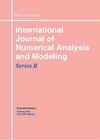A Posteriori Error Analysis for an Ultra-Weak Discontinuous Galerkin Approximations of Nonlinear Second-Order Two-Point Boundary-Value Problems
IF 0.7
4区 数学
Q1 MATHEMATICS
International Journal of Numerical Analysis and Modeling
Pub Date : 2023-06-01
DOI:10.4208/ijnam2023-1027
引用次数: 0
Abstract
. In this paper, we present and analyze a posteriori error estimates in the L 2 -norm of an ultra-weak discontinuous Galerkin (UWDG) method for nonlinear second-order boundary-value problems for ordinary di(cid:11)erential equations of the form u ′′ = f ( x;u ). We (cid:12)rst use the superconvergence results proved in the (cid:12)rst part of this paper ( J. Appl. Math. Comput. 69, 1507-1539, 2023) to prove that the UWDG solution converges, in the L 2 -norm, towards a special p -degree interpolating polynomial, when piecewise polynomials of degree at most p (cid:21) 2 are used. The order of convergence is proved to be p + 2. We then show that the UWDG error on each element can be divided into two parts. The dominant part is proportional to a special ( p +1)-degree Baccouch polynomial, which can be written as a linear combination of Legendre polynomials of degrees p (cid:0) 1, p , and p + 1. The second part converges to zero with order p + 2 in the L 2 - norm. These results allow us to construct a posteriori UWDG error estimates. The proposed error estimates are computationally simple and are obtained by solving a local problem with no boundary conditions on each element. Furthermore, we prove that, for smooth solutions, these a posteriori error estimates converge to the exact errors in the L 2 -norm under mesh re(cid:12)nement. The order of convergence is proved to be p + 2. Finally, we prove that the global e(cid:11)ectivity index converges to unity at O ( h ) rate. Numerical results are presented exhibiting the reliability and the e(cid:14)ciency of the proposed error estimator.非线性二阶两点边值问题的超弱不连续Galerkin逼近的后验误差分析
本文章由计算机程序翻译,如有差异,请以英文原文为准。
求助全文
约1分钟内获得全文
求助全文
来源期刊
CiteScore
2.10
自引率
9.10%
发文量
1
审稿时长
6-12 weeks
期刊介绍:
The journal is directed to the broad spectrum of researchers in numerical methods throughout science and engineering, and publishes high quality original papers in all fields of numerical analysis and mathematical modeling including: numerical differential equations, scientific computing, linear algebra, control, optimization, and related areas of engineering and scientific applications. The journal welcomes the contribution of original developments of numerical methods, mathematical analysis leading to better understanding of the existing algorithms, and applications of numerical techniques to real engineering and scientific problems. Rigorous studies of the convergence of algorithms, their accuracy and stability, and their computational complexity are appropriate for this journal. Papers addressing new numerical algorithms and techniques, demonstrating the potential of some novel ideas, describing experiments involving new models and simulations for practical problems are also suitable topics for the journal. The journal welcomes survey articles which summarize state of art knowledge and present open problems of particular numerical techniques and mathematical models.

 求助内容:
求助内容: 应助结果提醒方式:
应助结果提醒方式:


